书藏古今,港通天下。宁波是一座向海而生,因港而兴的城市。为了向世界讲好宁波故事,宁波发布推出“双语宁波”栏目,围绕历史、地理、人文、经济等多个方面聚焦“世界的宁波,宁波的世界”。
作为海上丝绸之路的起点城市之一,宁波自古就和世界各地往来密切。我们跟着宁波晚报“外国档案里的宁波”栏目,带大家换个视角,看看外国档案里的宁波是什么样子?
160多年前,宁波的市井烟火是什么模样?
What did the hustle and bustle of Ningbo's streets look like over 160 years ago?
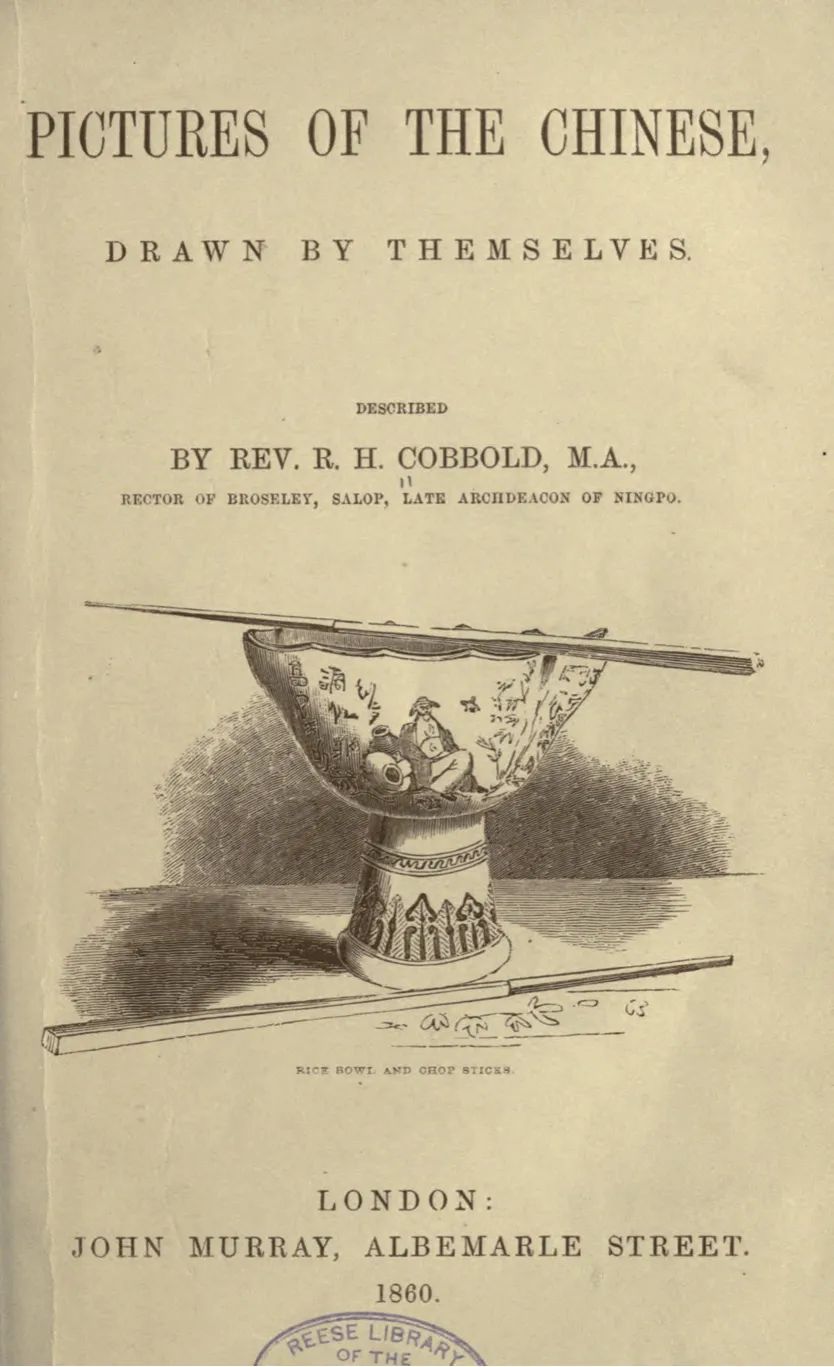
1860年伦敦出版的《Pictures of the Chinese》。
Pictures of the Chinese, published in London in 1860.
160多年前,宁波街头活跃着哪些小贩?牙医、糖贩、挑酒夫、卖灯笼的,还有花匠、石匠、理头师、挑水工分别是怎么工作的?
More than 160 years ago, which street hawkers and vendors were active in Ningbo? And how did these professionals ― dentists, sugar vendors, wine carriers, lantern sellers, as well as gardeners, stonemasons, barbers, and water carriers ― ply their trades and navigate their daily lives?
1860年,在伦敦出版的英文著作《中国人自画像》(直译),便是这样一本介绍晚清中国“三百六十行”的书。
Pictures of the Chinese, Drawn by Themselves was published in London in 1860 and the book introduced the various trades and professions of the late Qing Dynasty.
作者哥伯播义从在宁波、在浙江的生活经历与所见出发,描写晚清浙东地区的市井百态。每介绍一个行当之前,都以一张宁波画家的速写为引,以画引文、以文释画,图文并茂,承续了中国“左图右史”的叙事传统。
The author, Robert Henry Cobbold (1820-1893), offers a portrayal of the diverse tapestry of late Qing-era eastern Zhejiang’s urban life based on his residence of eight years in Ningbo and frequent travelling throughout Zhejiang Province. The book inherits the Chinese narrative tradition of “picture on the left and texts on the right,” and before introducing each profession, there would be a sketch presented (in the form of pen-and-ink etching and contributed by a native artist of Ningbo). The blend of images and words can set off each other for a richer reading experience.
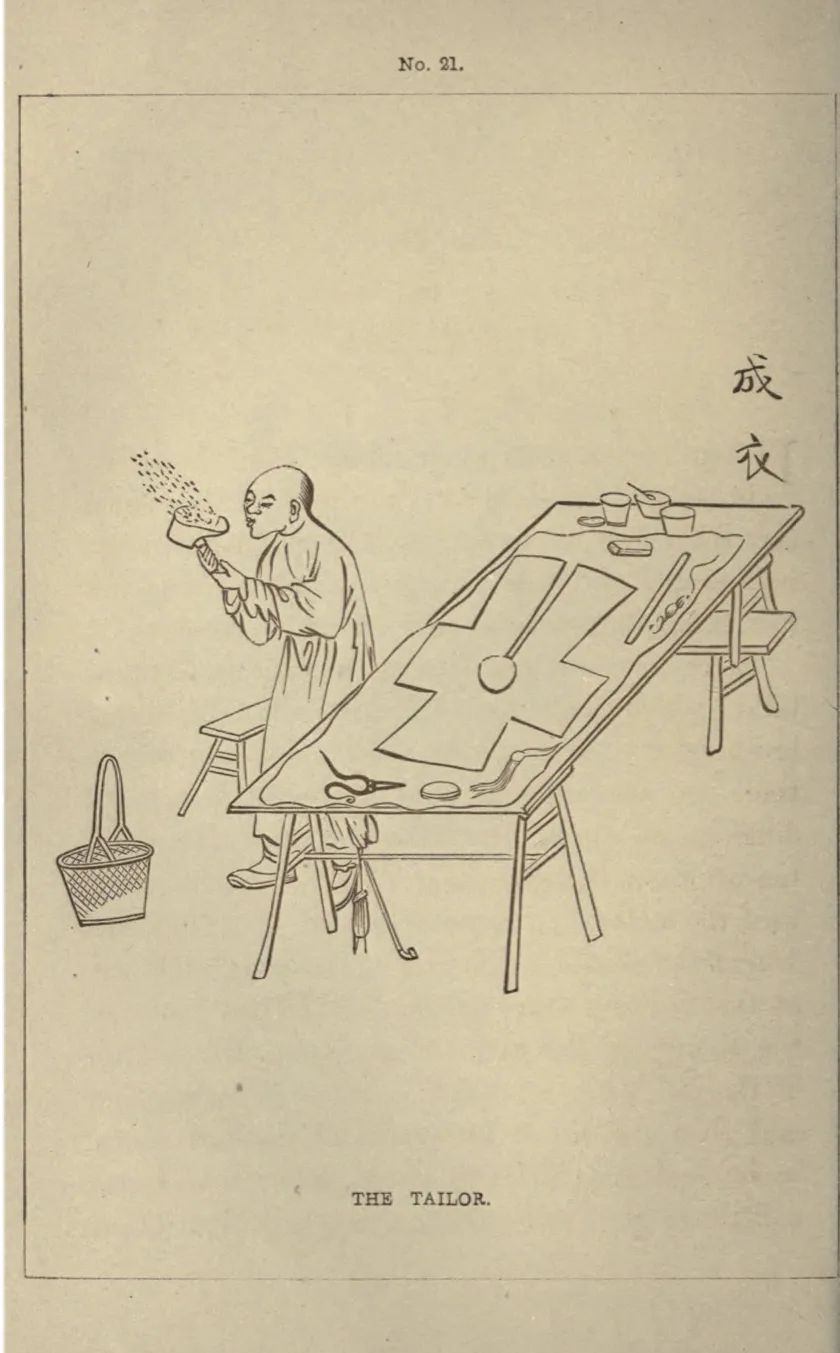
宁波画家所绘成衣裁缝。
A tailor making clothes, painted by a Ningbo artist.
该书也是少见的由西方人士写作,介绍中国人民日常生活的人文风俗画册,文字风趣,形象生动,充满市井烟火气。
This book stands out as a rare endeavor of Western authors, presenting a visual narrative of the humanistic customs and daily life of the Chinese people. Its entertaining and vivid writing brings an earthly atmosphere.
2017年,宁波市第三中学英语教师刘犇将该书译成中文《市井图景里的中国人》,收入学林出版社“欧美汉学丛书·史地风俗系列”。
2017 saw the translation of this book into Chinese. Xuelin Press included the work in its series of History, Geography and Customs within European and American Sinology. Notably, its translator is Liu Ben, an English teacher at Ningbo No. 3 High School.
女牙医和字纸篓
Female Dentist and Wastepaper Basket
《市井图景里的中国人》一书的作者哥伯播义是英国圣公会传教士,1846年毕业于剑桥大学彼得豪斯学院。
Cobbold, author of Pictures of the Chinese, Drawn by Themselves, was an Anglican missionary, who graduated from Peterhouse College of Cambridge University.
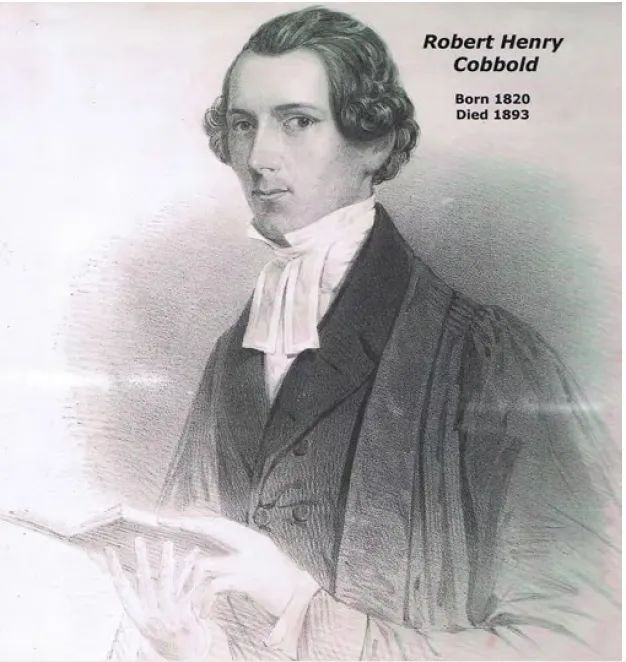
哥伯播义。
Cobbold.
他于1848年来华并在当年5月13日抵达宁波。1851年9月返回英国述职,1853年1月携夫人重返宁波,直到1857年3月返英,两次一共在宁波生活了近八年,这期间也曾往浙江各地旅行。
Cobbold came to China in 1848 and arrived in Ningbo on May 13th of the same year. In September 1851, he returned to England to report on his duties and then came back to Ningbo with his newlywed wife in January 1853. They lived there until March 1857, spending a total of eight years in this Chinese coastal city, during which he also traveled to various places across Zhejiang.
《市井图景里的中国人》一书素材便是在此期间积累。全书一共30章,每章介绍一个行业,从内容看,涉及婚丧嫁娶、年俗节庆、饮食服饰、工匠艺人、巫医术士、算命卜卦等各行各业。
Whilst in China he prepared his book, Pictures of the Chinese, Drawn by Themselves, which was published by John Murray in 1860. Each chapter of the 30-chapter book introduces a local profession, ranging from weddings and funerals, festivals and customs, food and clothing, craftsmen and artists, Taoist priests and physicians, and diviners and seers.
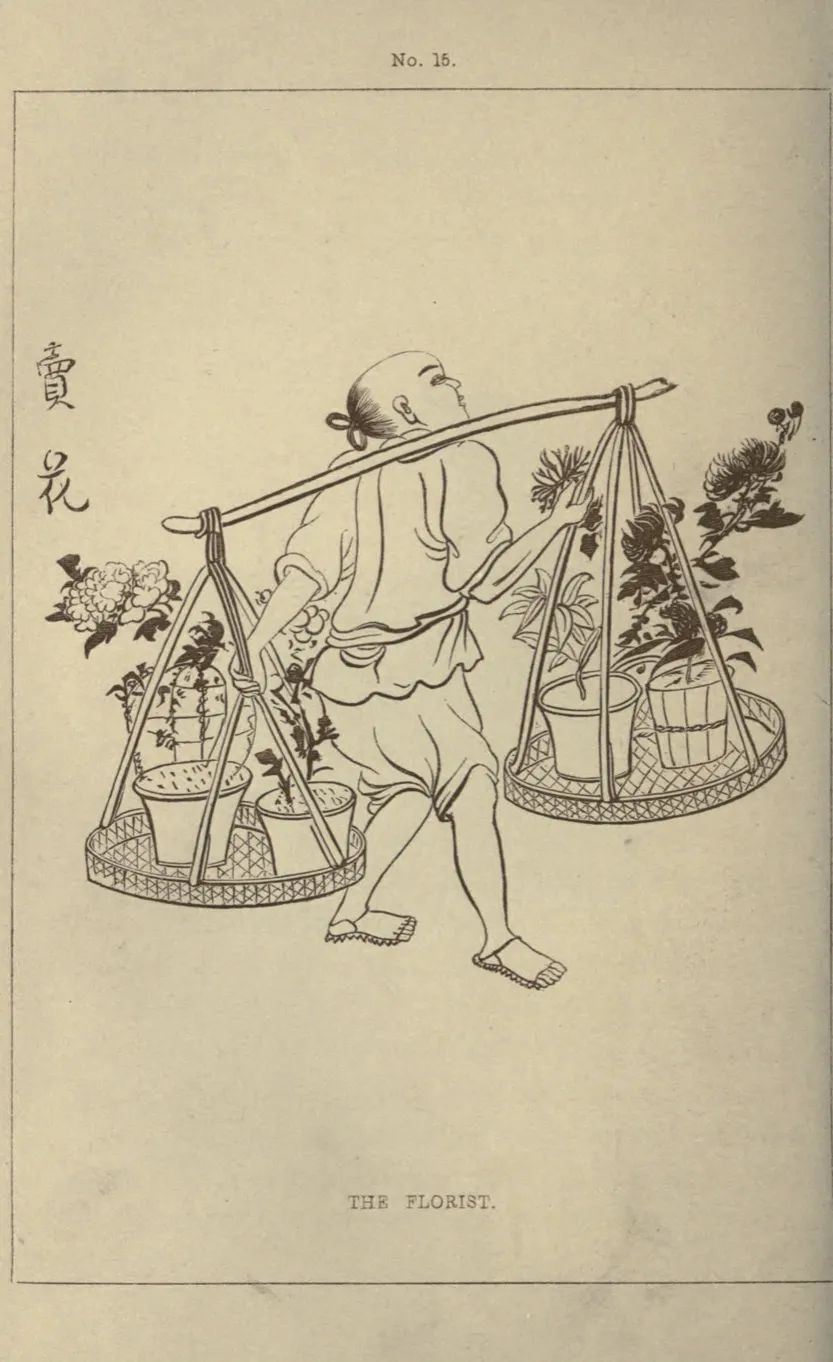
街头卖花郎。
A street florist.
比如第1章“江湖女牙医”介绍了宁波地区女游医给人“捉牙虫”的详细过程。“阿婆箝牌捉牙虫”是宁波老话童谣中的一句,当时生活在宁波的西方人对这种神秘的医术有浓厚的兴趣并将信将疑,哥伯播义决定“以身试法”,用生动的细节捕捉了整个过程……
For example, Chapter 1 (“The Infallible Remedy”) describes in detail how female quacks in Ningbo extract toothworms or maggots for people. The verse “Granny plays a trick to coax toothworms out” comes from an old Ningbo nursery rhyme. Westerners living in Ningbo at the time were keenly interested in but skeptical of this mysterious healing remedy, so Cobbold decided to "test it out" and recorded the whole process in vivid and engaging prose ...
“我们的版画就是这类女牙医的真实写照:她们为人熟知的是她们的长柄雨伞、整洁的头巾和小脚,还有那一旦遭到粗鲁攻击便随时准备应战的顽强性格。”哥伯播义描述。
“Our engraving conveys a very truthful representation of this class of women: they are known by their long umbrellas, their small feet, and their very neat head-dress, and have the character of being well able to defend themselves if rudely attacked.” Cobbold depicts.
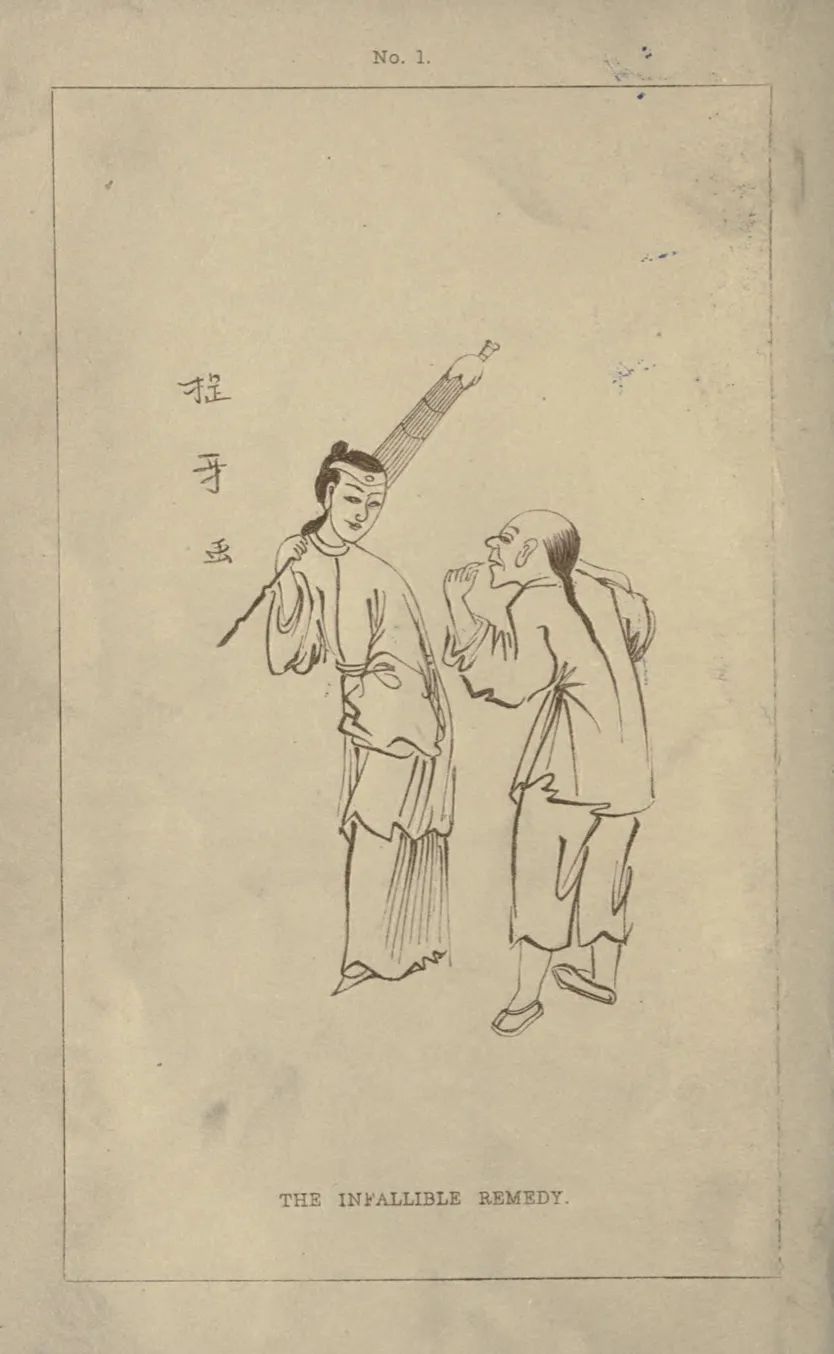
女牙医“捉牙虫”。
A female dentist "removing toothworms".
还有一张画“收字纸”也常被引用。中国古代有敬惜字纸的传统,写剩的纸张需投入字纸炉焚烧。今天的宁波天童寺门口仍保留了一个惜字炉,上有楹联“敬惜字纸福德无量,爱护文宝世代流芳”。
Another frequently cited etching is “The collector of Paper Scraps”. In ancient China, there was a tradition of revering and sparing printed paper, and the waste-paper had to be put into a separate fireplace, often erected in the side court of a temple, to be incinerated. Today, Tiantong Temple in Ningbo still retains a word-sparing furnace, on which there is a couplet “Venerate words and paper for infinite blessings, cherish literary treasures for generations to come”.
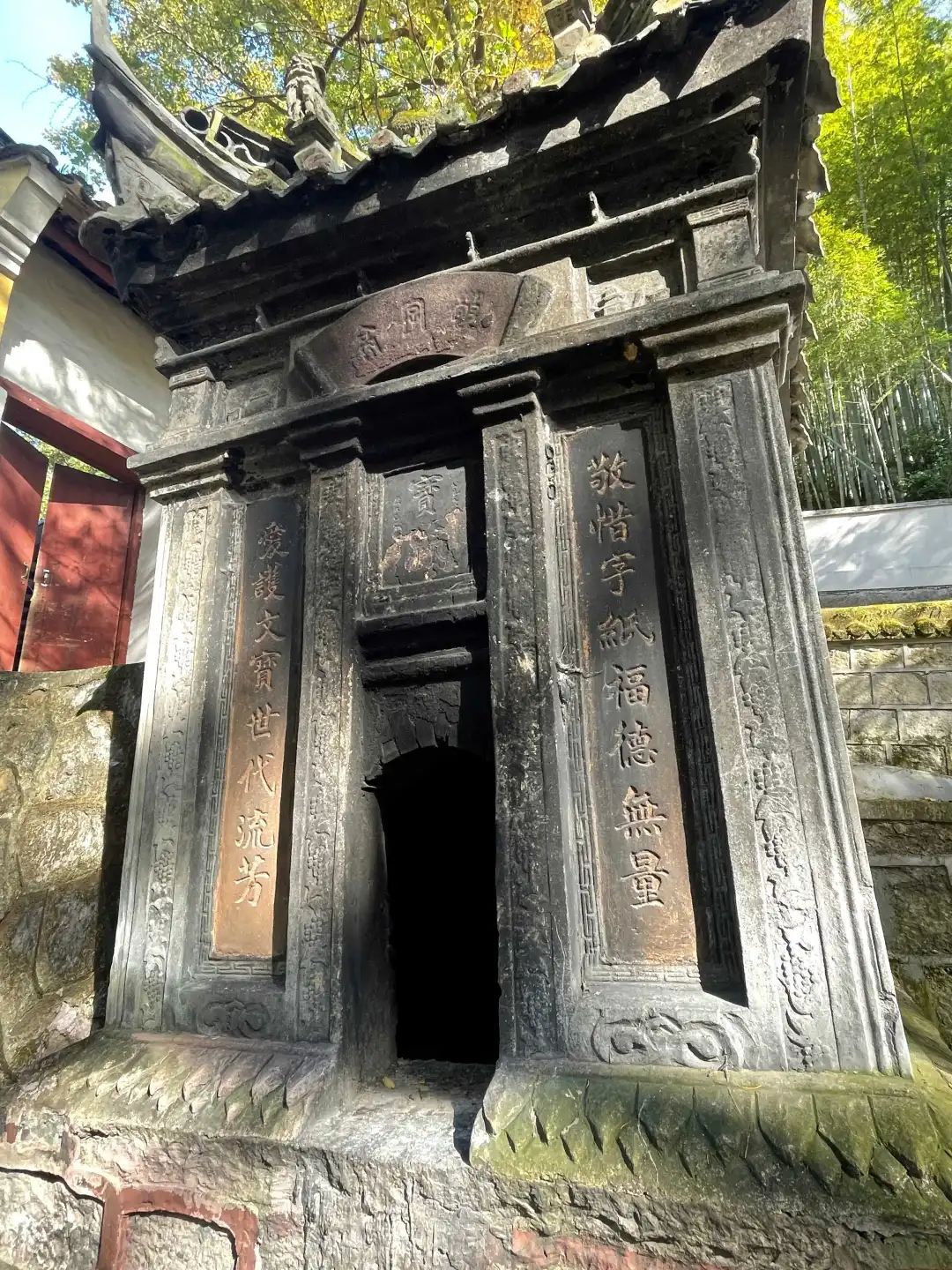
宁波天童寺门口的惜字炉。
The Word-Sparing Furnace at the entrance of Tiantong Temple in Ningbo.
“每个读书人都会在书房里放一个废纸篓。这幅图中,站在门口的这个男人手上所拿着的正是这个废纸篓。”哥伯播义描述插图说,“当那个背着大筐的男人大喊‘敬惜字纸’时,读书人会亲自或让仆人去门口,把纸篓里的所有纸张倒到那个又轻又大的柳条筐里。”图中的柳条筐上写着“永敬社”,上插小旗写着“广文会敬惜字纸”。
“Every scholar keeps in his study a waste-paper basket, which is accurately represented in the hand of the figure standing at the door of his house.” Describing the illustration, Cobbold says, “When the cry of the man with the large baskets, King sih sze tsze, ‘Revere and spare the printed paper’ is heard, then he will go or send his servant to the door, and empty the contents of his basket into the light and capacious skep of the collector.” The wicker basket in this illustration has “Yongjingshe” written on it, with a small flag that reads, “Guangwenhui reveres and spares the printed paper”.
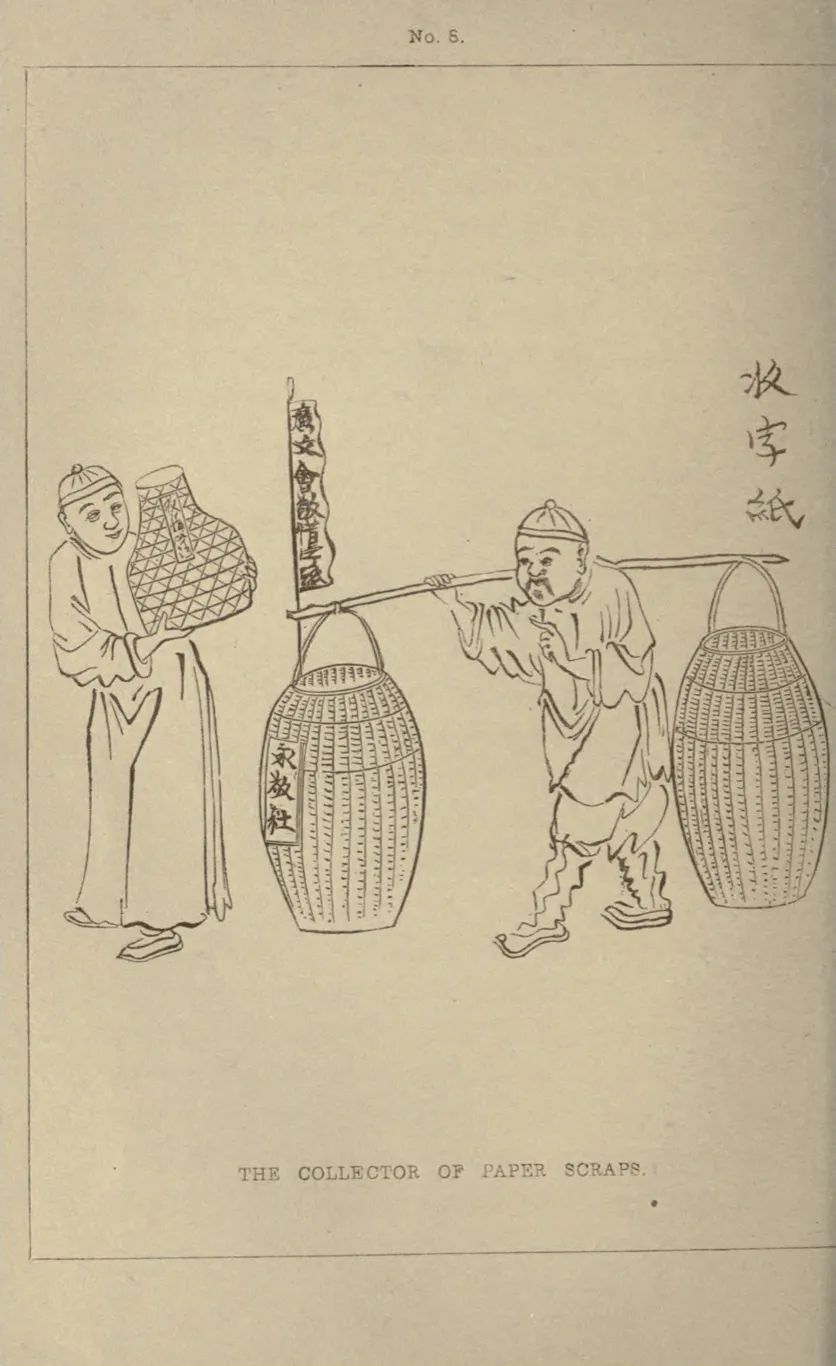
收字纸。
The Collector of Paper Scraps.
路边摊和菜市场
Roadside stalls and bazaars
人间烟火哪里寻?还看路边小吃摊和菜市场。
Within the bustle and hustle of roadside stalls and bazaars, you can find the earthly joy of Chinese society.
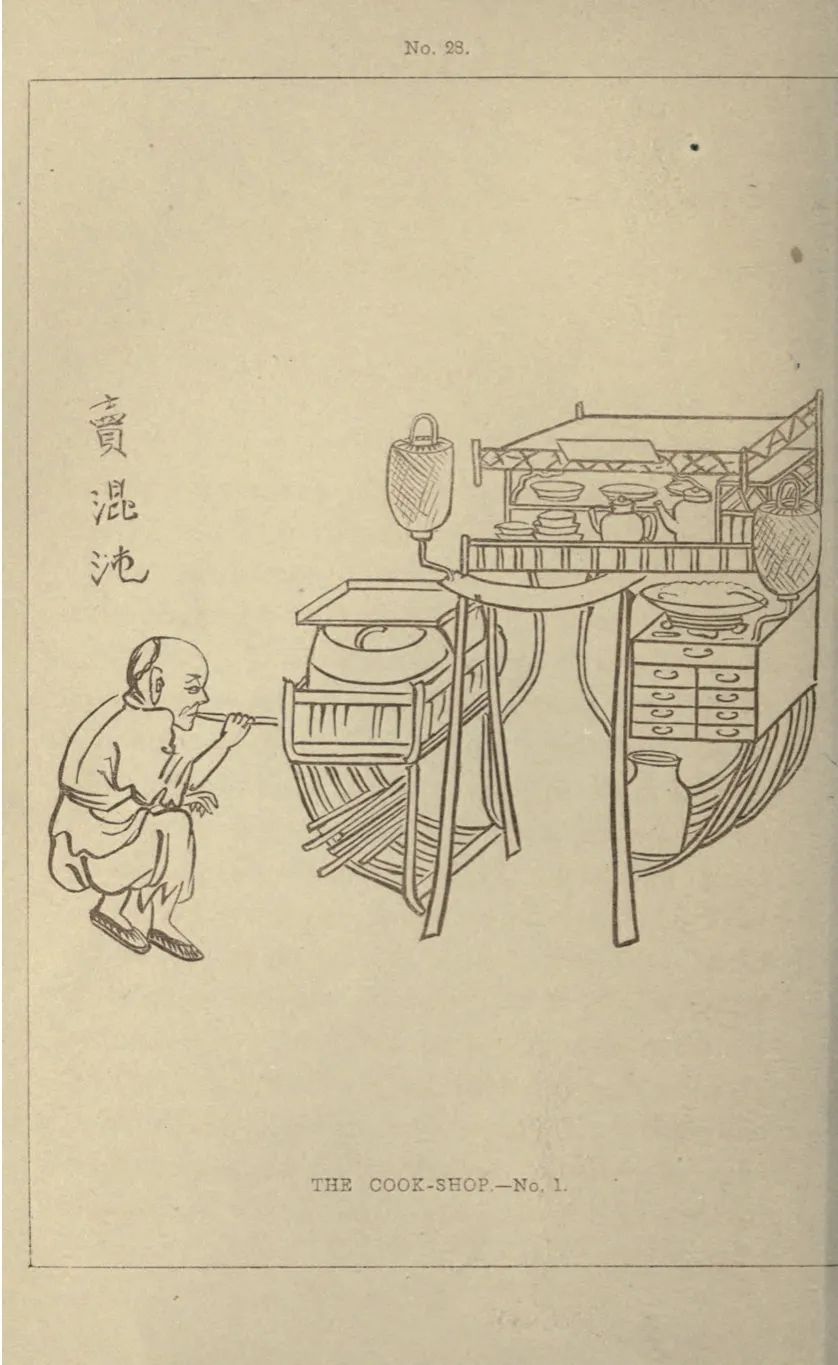
卖馄饨,有两个灯笼可能是出夜摊。
Selling wontons at a night stall with two lanterns.
《市井图景里的中国人》的第28章,聚焦了小吃摊。该章节一共用了4幅画面,分别是“卖馄饨”“卖石花”“卖豆浆”和“卖汤圆”。哥伯播义形容,“在精准度上,照片都很难超越这些图画。”
Chapter 28 of Pictures of the Chinese, drawn by themselves focuses on the food stalls, presenting us with four illustrations: “selling wonton,” “selling gelidium jelly,” “selling soybean milk” and “selling tangyuan.” As written by its author, Robert Henry Cobbold, “Photography itself could hardly exceed in the accuracy of these drawings.”
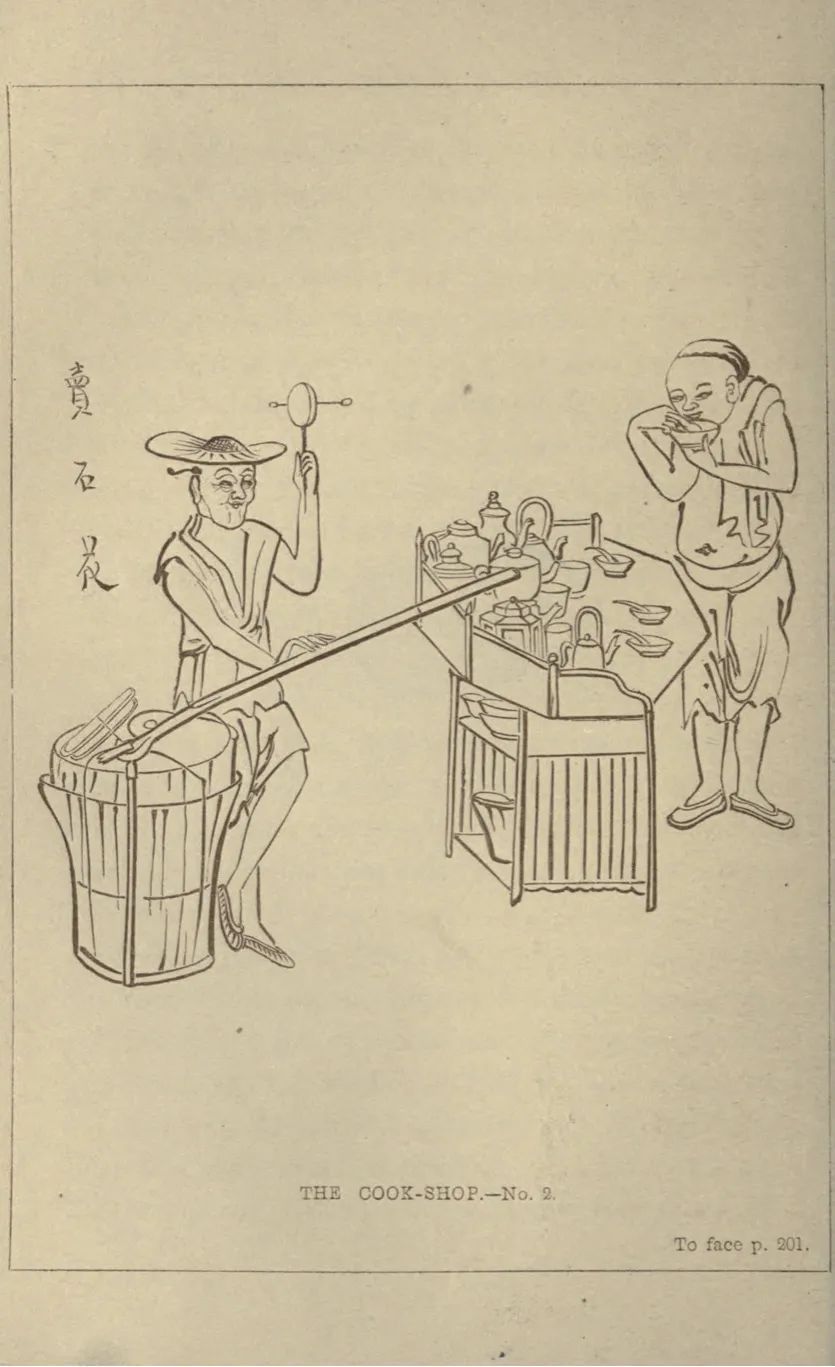
卖石花。
Selling gelidium jelly.
“如图所示的小摊,往往是由摊主背在背上,然后在某个比较合适的街角安顿下来。小摊会待在那儿,直到所有食物都卖完……据我偶尔的观察,我认为这个小摊里诱惑我们味觉的主要食物是一种非常小的用米粉做成的汤圆,里面包裹着甜甜的馅,在甜汤里炖着……从这个便携式的小吃摊上挂着的两个纸灯笼,我们可以得知摊主准备为夜里的客人开设‘餐馆’。”
“A stall, like that engraved on the opposite page, is carried on the back of the owner, and set down at some convenient corner of a street, where it remains till purchasers have exhausted its contents. … If I may give the result of occasional investigation, I should say that the chief article of food which here tempts the palate, consists of very small rice-flour dumplings, stuffed with a sweet confectionery, and stewed in sweetsauce. … By the two paper lanterns attached to the portable cook-shop, we are reminded that the owner is preparing to open his restaurant for evening customers.”

卖豆浆。
Selling soybean milk.
文字中,可以感觉哥伯播义其实并不能精准分辨四个小摊之间的不同,但从头到尾,他都对中国的美食不吝赞词——“很少有国家能像中国这样,生产出如此多样的便宜又美味的食物;能和中国人较量厨艺的国家就更少了。虽然中国富人家的餐桌上没有牛羊肉,但是在菜式种类上,英国任何贵族家的餐桌都很难超越他们。”
Although he found it somewhat challenging to accurately distinguish the unique snacks offered by the four stalls, his descriptions of these Chinese delicacies clearly convey his admiration — “I will venture to state my conviction that there are few countries which produce such a variety of cheap and good food as China; fewer still which will bear comparison with her people in the art of cooking. Although no mutton or beef is used at the tables of the wealthy, yet the variety of entrees is hardly exceeded by any nobleman’s table in England.”

卖汤圆。
Selling tangyuan.
在第29章,哥伯播义还详细描述了宁波集市上的“菜市场”。
In chapter 29, Cobbold also offers a detailed description of various fresh goods available at the Ningbo bazaar.
“市场上提供很多种商品。这里有像蛇一样的鳗鱼,它们在大盆里扭动身体,相互缠绕;那里一桶桶去壳的牡蛎刚刚由强壮的苦力们从二十英里远的地方背来;这里有大小不一的螃蟹,其中的棕色小螃蟹在一年中的两个月里都被拿来活着生吃,只要蘸点醋汁就可入口;或者如果你更喜欢吃大螃蟹,有一种被浸泡在盐水里的,这种螃蟹就像美国的牛肉火腿一样,把它煮熟就糟蹋它了。”后者显然指的是宁波的红膏呛蟹。
“The market supplies you with a great variety of good provision[s]. Here are snake-like eels wriggling and intertwining in large pans; there pails of oysters without their shells, just brought, on the backs of strong coolies, a distance of twenty miles. Here, again, are crabs of every size, from the little brown variety, which, for two months in the year, are eaten raw and alive, being merely dipped into a saucer of vinegar on their way to your mouth; or, if you prefer them, there is the large kind which have been preserved in brine, and which, like the beef-hams of America, to cook is to spoil.” “The larger kind” obviously refers to the Ningbo red cream crab.
在市场上,哥伯播义还发现了海参、青蛙、甲鱼,以及鸟蛤、玉黍螺、贻贝等等“其它一些叫不上名字的贝类”。
In the market, Cobbold also encountered trepangs, frogs, soft shell turtles, cockles, periwinkles, mussels, and several other shellfish he couldn’t identify.
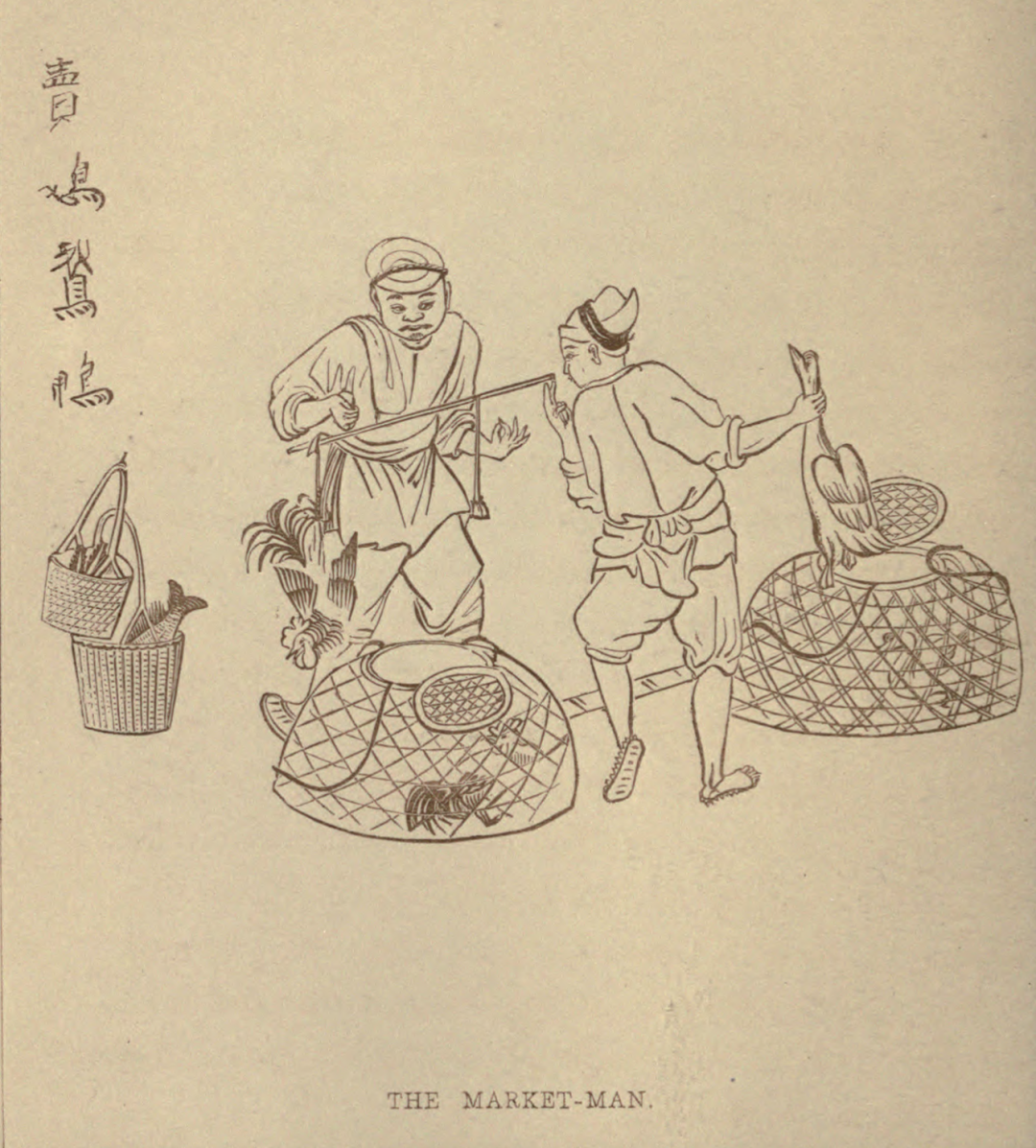
市场上卖鸡鹅鸭。
Selling chickens, geese and ducks at the market.
宁波的“工匠精神”
Ningbo Craftsmanship
哥伯播义还对许多工匠有着细致的观察,比如针匠、花匠、石匠、剃头匠、裁缝、鞋匠、铜匠等。
Cobbold also made detailed observations of the craftspeople in China, including needle-makers, florists, stone-squarers, barbers, tailors, cobblers, and braziers.
其中“石匠”一章,他回忆了曾经两次从宁波去余姚大隐采石场的经历。“居住在宁波城的外国人,对大隐采石场的景象都非常感兴趣。这些采石场位于宁波城北约15英里处,可以乘船直达,亦可水陆兼程。不过后者似乎会让旅程更加有趣些。”
In a chapter on stone-squarers, Cobbold recalled his two trips to the stone quarries in what is now Dayin Town, Yuyao County, Ningbo. He wrote: “A common object of interest to foreigners residing at Ningpo, is the scene of the stone quarries at Da-ying. They lie about fifteen miles to the north of the city, and may be reached either altogether by water, or partly by water and partly by land. The latter forms the more interesting journey.”
“山脚下,就在这条通往石块开采地的崎岖石径之前的空地上,堆积着大量的石块。这些石块是被人用坚固实用的手推车或者肩扛扁担运下来的,放在此处等待出售。甬江的一条支流恰好经过这里,为运输提供了便利。”
“At the foot of the hill, just before the rugged pathway winds into its excavated side, masses of stone meet the eye, which have been brought down thus far either on strong and effective barrows, or by means of poles on men’s shoulders. They lie ready for the merchant, for a branch of the Ningpo river runs up to this point, and affords convenience for transport.”

石匠。
The stone-squarers.
“我们的版画中右手边那个人正在用一把锋利的凿子削除石头上面粗糙的地方。另外两人由于找不到更合适的座位,只好各自坐在自己的工具箱上,每人手上都握着一把厚重的铁锤,锤子的手柄则是用一块非常粗糙的、带有韧性的木头做成。”
“The right-hand figure of our etching shows a workman engaged in cutting off with a strong chisel some roughnesses in the stone. The two other figures, each sitting upon his box of tools for want of a better seat (a very common feature in Chinese economy), are each of them armed with a thick and heavy iron mallet-head, attached to a pliant handle of very tough wood.”
“那两个忙于磨平石面的工匠之所以把辫子盘到头顶,是为了避免辫子受损,也防止干活时产生的灰尘弄脏头发。另一个更普通的石匠,将头发扎起来盘了两个发髻,然后用一支光滑的竹管将其固定……”
“The two workmen engaged in smoothing the surface of the stone block have only thought it necessary to wind their queues round the top of their head, and so keep them out of harm’s way, and prevent their being soiled by the dust which their employment creates. The other, a more ordinary workman, whose toil is rougher and more laborious, has gathered his hair into a peculiar double knot, which he fastens with a smooth short pin of bamboo.”
在介绍这些石料的去处时,哥伯播义对于中国石匠的手艺颇为赞赏,表示“这些人绝不缺乏才华,我们必须说中国石匠不输于这个国家的任何人,他们在工匠当中堪称一流”。
Regarding the employment of the produced stone blocks, Cobbold highly admired the skills of Chinese stone artisans, stating, “...we must say of the Chinese stone-cutters that they are not behind the rest of their countrymen, and make good their claim to a high grade in the rank of artizans.”

铜匠。
The brazier.
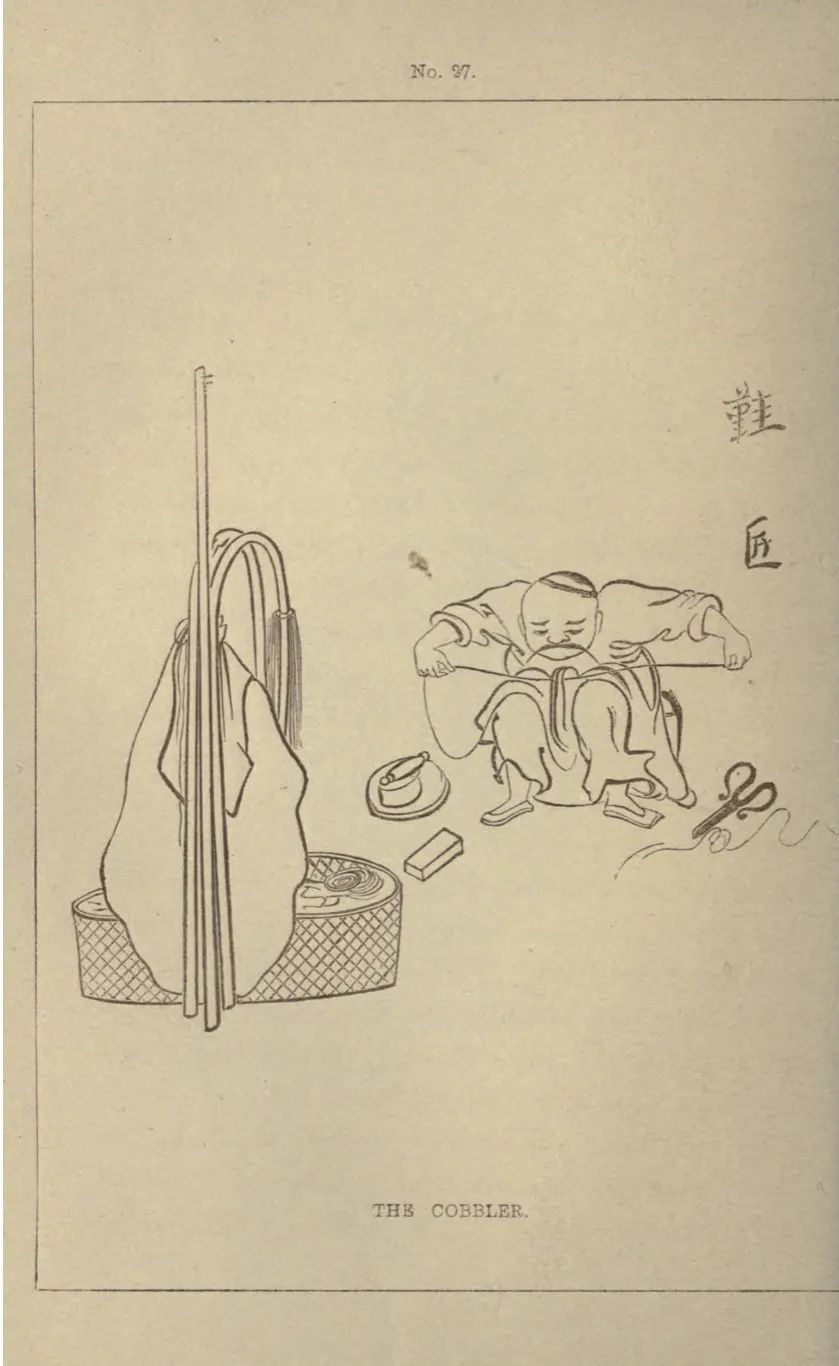
鞋匠。
The cobbler.
而除了观察市井人情,在宁波期间,哥伯播义还曾和丁韪良、禄赐悦理、岳腓烈等同时在甬的其他外国人士,一起制定过一套用罗马字母拼写宁波话的方案,并用这种表音方式编写了地理、地图、算术等各种通俗小册子,以便与宁波人交流,间接影响后来的汉语拼音方案。
During his stay in Ningbo, Cobbold did more than just observe local life; he partnered with fellow missionaries like William Alexander Parsons Martin, William Armstrong Russell and Frederick Foster Gough to develop a Romanized system for transcribing the Ningbo dialect. This phonetic system was used to create pamphlets on subjects such as geography, cartography, and arithmetic, facilitating better communication with the local community. Their work indirectly paved the way for the later development of the Mandarin Chinese Pinyin system.
他也曾在宁波贯桥头(今解放北路)寓所创办寄宿制学校,后发展成“义塾”,也即后来宁波三一书院(宁波市第三中学前身)的雏形。
Cobbold also founded a boarding school at his residence in Guanqiaotou (now Jiefang North Road), which subsequently transformed into a charitable institution known as "Yishu." This institution then evolved into Ningbo Trinity Academy, and today it stands as Ningbo No. 3 Middle School.
《Pictures of the Chinese》一书应当完成在他离开宁波回到英国之后。他拿着从中国带回的数十张木版画,开始了他对中国生活的回忆。
The book Pictures of the Chinese was likely completed after Cobbold left Ningbo and returned to Britain. Drawing on dozens of woodblock prints he brought back, Cobbold started to compile his experiences and memories of China.
画家是谁?
Who’s the painter?
据宁波文史研究者水银告知,为《市井图景里的中国人》作画的画家姓名,慕雅德在1878年版的《圣公会浙江传教记事》一书中曾经透露过,他就是“戴马太”。
According to Shuiyin, a Ningbo literature and history researcher, the name of the artist who illustrated Pictures of the Chinese, Drawn by Themselves was revealed by Arthur Evans Moule (1836-1918) in the 1878 edition of The Story of the Cheh-Kiang Mission of the Church Missionary Society. The artist was “Matthew Tai.”
原文大意为:“戴马太是一位年约45岁的宁波艺术家。应朋友的要求,他画了关于中国行业和职业的巧妙素描,后来由哥伯播义在他的《市井图景里的中国人》中出版……”
The original article states: “Matthew Tai is a Ningpo artist about forty-five years of age. Some twenty-five years ago he made, at the request of his friend Sing Engteh, now a Christian Presbyter, but then, like himself, an artist, some clever sketches of Chinese trades and occupations, afterwards published by the Rev. R. Cobbold in his ‘Pictures of the Chinese, drawn by themselves’ ...”
很巧合的是,为慕雅德《年轻的中国》(1908年出版)一书画插图的也是这位“戴马太”。根据他在插图上的落款,可知他也叫戴恩泉,别号痴道人,“马太”应是他的教名,作画时75岁。
Coincidentally, the artist who provided the illustrations for Arthur Evans Moule’s book Young China (published in 1908) was also “Matthew Tai”. His signature on the illustrations reveals that he was also known as Dai Enquan, with the alias “Idiot Taoist,” while “Matthew” was presumably his Christian name. At the time of creating the artwork, he was 75 years old.
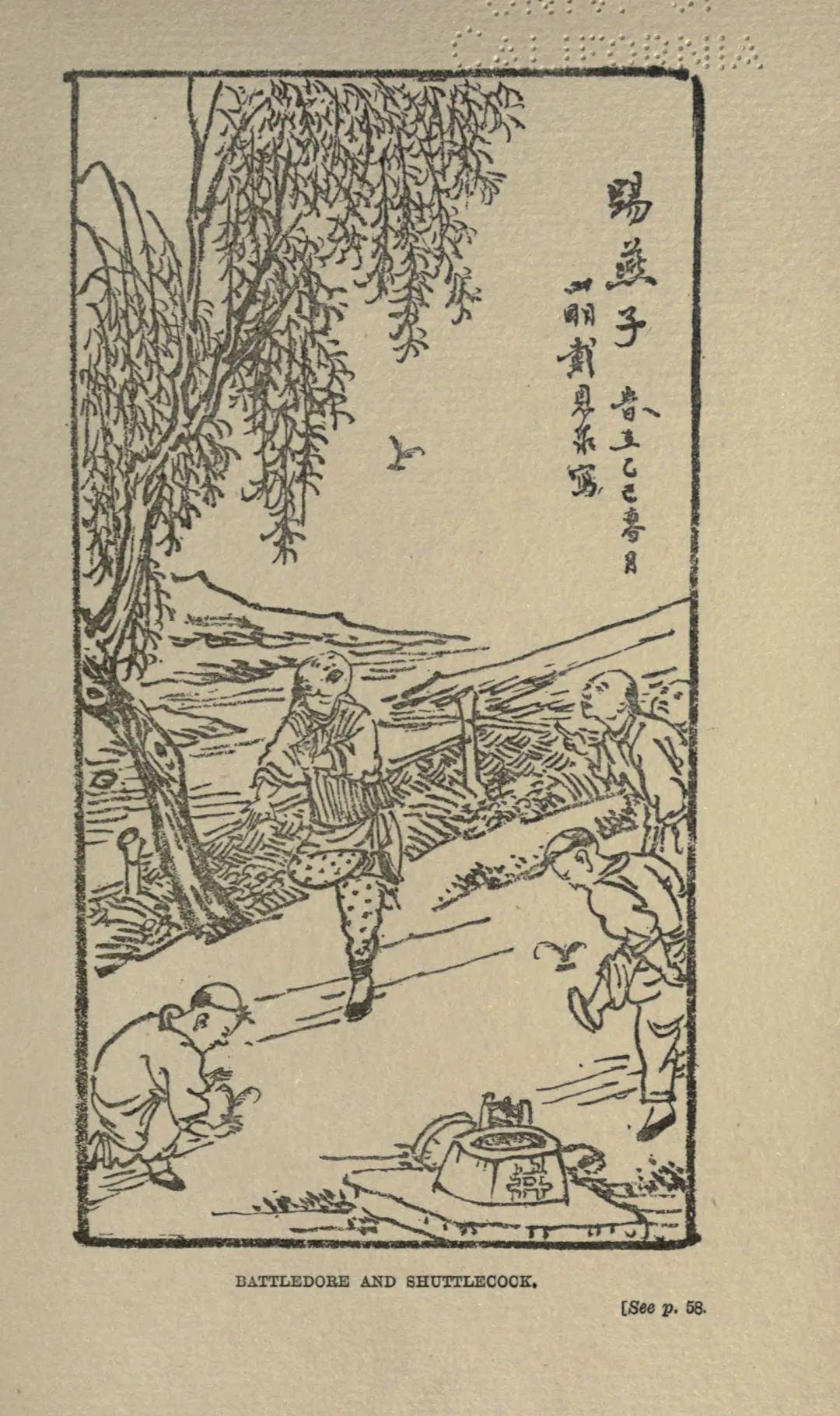
《年轻的中国》插图“踢燕子”右上角有画家落款,从而可以知道他的姓名。
In the illustration "Kicking Swallows" from Young China, there is the painter's signature in the upper right corner, through which his name can be identified.
慕雅德在《年轻的中国》文末介绍这位艺术家说,他生前在茶馆里演奏琵琶为生,给人作画赚点小钱,在76岁时去世。
Arthur Moule concluded Young China by introducing the artist, noting that he made his living partly by playing the lute in wine- and tea-shops, and partly by using his skill in drawing pictures to be worshipped before he died at the age of 76.
综合各种材料,可推知戴恩泉出生于1830年前后,是一位正史不载的宁波民间艺术家。
By synthesizing all kinds of materials, it can be deduced that Dai Enquan was born around 1830 and was a Ningbo folk artist who was not recorded in the official history.
来源:宁波晚报、宁波发布







